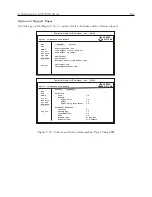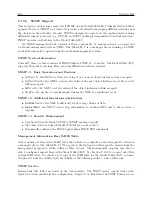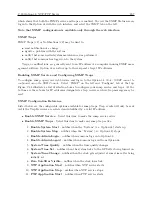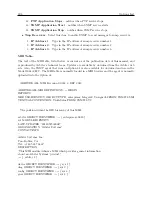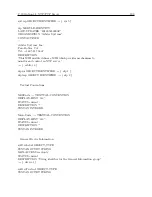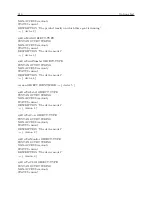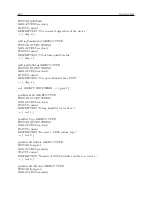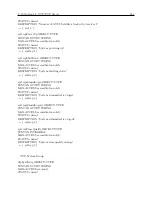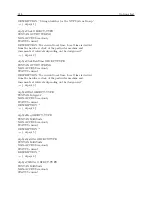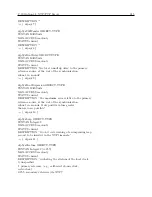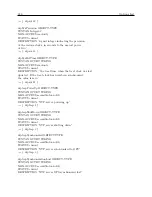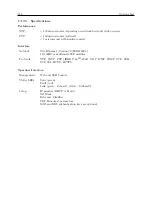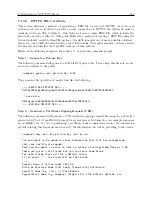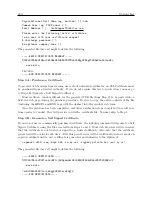
C.19 Option 34: NTP/PTP Server
219
C.19.6
HTTPS/SSL Certificate
This section discusses a method of generating a PEM file for use with HTTPS. As is the case
with any web server, in order to provide a secure connection via HTTPS, the Option 34 must be
configured with an SSL Certificate. The Option 34 uses a single PEM File which includes the
private key and the certificate. This guide illustrates a method of creating a PEM File using the
free and publicly available OpenSSL package. OpenSSL is merely one of many possible solutions –
please see your toolkit documentation for exact instructions. This guide assumes you have already
downloaded and installed the OpenSSL tools on a Linux system.
Note:
In the following examples, the symbol ‘
B
’ denotes the command prompt.
Step 1 - Generate a Private Key
The following command will generate a 1024 bit RSA private key. Please keep this file safe, secure,
and not accessible to the public.
B
openssl genrsa -out private.key 1024
The generated file (private.key) might look like the following:
-----BEGIN RSA PRIVATE KEY-----
MIICXgIBAAKBgQDPoNigXmq2JAlw9DrD0P5Og5c5xsEnt9bPjfuE7MGkDEGN09sC
...more data...
8Xxzzgu4xizBdLmONkHu7b/h7GL6u5smkWVOCesCCR0mKw==
-----END RSA PRIVATE KEY-----
Step 2 - Generate a Certificate Signing Request (CSR)
The following command will generate a CSR (certificate signing request) file using the private key
generated in Step 1. OpenSSL will prompt for several pieces of information, our example responses
are in BOLD text. If you are purchasing a certificate from a commercial vendor, the information
provided during this step must match exactly the information you will be providing to the vendor.
B
openssl req -new -key private.key -out my.csr
You are about to be asked to enter information that will be incorporated
into your certificate request.
What you are about to enter is what is called a Distinguished Name or a DN.
There are quite a few fields but you can leave some blank
For some fields there will be a default value,
If you enter ‘.’, the field will be left blank.
-----
Country Name (2 letter code) [AU]:US
State or Province Name (full name) [Some-State]:California
Locality Name (eg, city) [ ]:Paso Robles
Organization Name (eg, company) [Widgits Pty Ltd]:Arbiter Systems, Inc.
Summary of Contents for 1084A
Page 4: ...iv ...
Page 6: ...vi ...
Page 18: ...xviii LIST OF FIGURES ...
Page 24: ...4 Unpacking the Clock ...
Page 36: ...16 Connecting Inlet Power Input and Output Signals ...
Page 44: ...24 GPS Antenna and Cable Information ...
Page 114: ...94 Startup and Basic Operation ...
Page 123: ...B 4 Physical Dimensions 103 Figure B 1 Suggested Mounting of the AS0094500 Surge Arrester ...
Page 124: ...104 Using Surge Arresters ...
Page 134: ...114 Options List C 6 2 Option 06 Firmware Setup Figure C 3 Option 06 Firmware Setup ...
Page 142: ...122 Options List Figure C 5 Option 06 Output Jumper Settings ...
Page 158: ...138 Options List Figure C 13 Option 17 Board Layout and Jumper Locations ...
Page 163: ...C 13 Option 20A Four Fiber Optic Outputs 143 Figure C 14 Option 20A Jumper Locations ...
Page 170: ...150 Options List Figure C 16 Option 23 Internal Jumper Setup ...
Page 172: ...152 Options List Figure C 17 Option 27 Jumper Locations ...
Page 190: ...170 Options List Figure C 20 Option 29 Connector Signal Locations ...
Page 246: ...226 Options List ...

